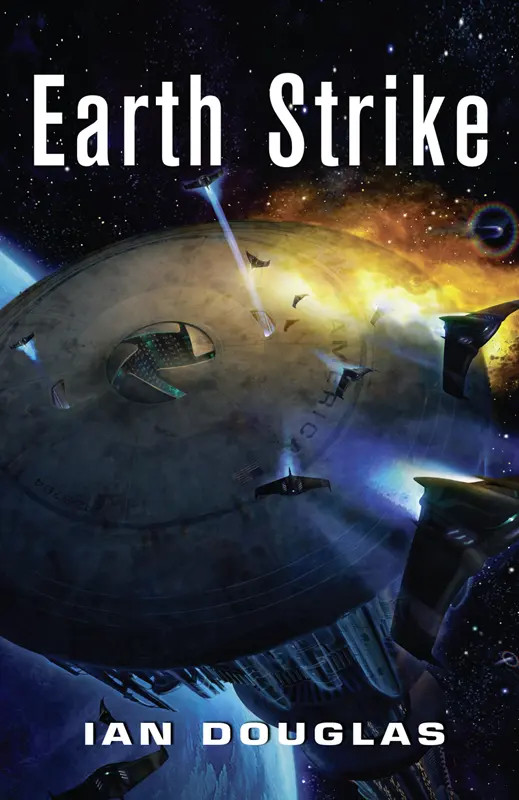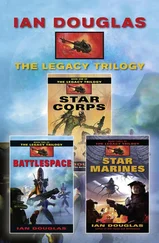Ian Douglas
The Star Carrier Series Books 1–3

Table of Contents
Cover
Title Page Ian Douglas The Star Carrier Series Books 1–3
Earth Strike
Centre of Gravity
Singularity
Extract from Deep Space
By Ian Douglas
About the Author
Copyright
About the Publisher

“Too little, too late, I fear. We have lost the planet, either way.”
He dipped his gravfighter’s nose and accelerated.
He wasn’t quite “down to the deck,” as he’d reported, but close enough. The Starhawk was dropping now past the twenty-kilometer mark. The sky above was still space-dark, the brightest stars—Arcturus, especially—still gleaming and brilliant, but the cloud decks below rose thick and towering, their tops sculpted by high-altitude winds and tinted red and gold by the rising sun. He’d crossed enough of the planet’s face that the local sun was well above the horizon now, casting long, blue-purple shadows and hazy shafts of golden light across the distinctly three-dimensional surface of the cloudscape below.
Gray adjusted his ship’s hull-form again, sculpting it for high-speed aerial flight, absorbing the deep entry keel and extending the wings farther and deeper into their forward-canted configuration. Behind him, a sudden burst of shooting stars marked another cloud of sand or debris entering atmosphere, a barrage of silent flick-flick-flicks of light.
He let his AI target on the Marine beacon, bringing the SG-92’s prow left across the horizon, then dipping down into a plunging dive. He opened his com suite to the Marine frequency and began sending out an approach vector clearance request.
He hadn’t crossed seventy-one AUs and survived a near-miss by a thermonuke to get shot down by the damned jarheads.


For Brea, who has seen me through many, many light years
Table of Contents
Too little, too late, I fear “Too little, too late, I fear. We have lost the planet, either way.” He dipped his gravfighter’s nose and accelerated. He wasn’t quite “down to the deck,” as he’d reported, but close enough. The Starhawk was dropping now past the twenty-kilometer mark. The sky above was still space-dark, the brightest stars—Arcturus, especially—still gleaming and brilliant, but the cloud decks below rose thick and towering, their tops sculpted by high-altitude winds and tinted red and gold by the rising sun. He’d crossed enough of the planet’s face that the local sun was well above the horizon now, casting long, blue-purple shadows and hazy shafts of golden light across the distinctly three-dimensional surface of the cloudscape below. Gray adjusted his ship’s hull-form again, sculpting it for high-speed aerial flight, absorbing the deep entry keel and extending the wings farther and deeper into their forward-canted configuration. Behind him, a sudden burst of shooting stars marked another cloud of sand or debris entering atmosphere, a barrage of silent flick-flick-flicks of light. He let his AI target on the Marine beacon, bringing the SG-92’s prow left across the horizon, then dipping down into a plunging dive. He opened his com suite to the Marine frequency and began sending out an approach vector clearance request. He hadn’t crossed seventy-one AUs and survived a near-miss by a thermonuke to get shot down by the damned jarheads.
Title Page
Dedication For Brea, who has seen me through many, many light years
Author’s Note Author’s Note Readers of the Galactic Marines series may wonder at first why the background for Earth Strike seems so different from the universe of Heritage, Legacy, and Inheritance. Where are the Xul, the Builders, the Marine Corps families and traditions extending across two millennia? There’s a simple explanation. Earth Strike is the opening volley of a completely new military-SF series, Star Carrier, which explores the lives of Navy combat fighter pilots of the far future. Welcome aboard the Star Carrier America as she faces a new and deadly threat to Earth and all of humankind. I hope you enjoy the cruise! Ian Douglas December 2009
Prologue
Chapter One
Chapter Two
Chapter Three
Chapter Four
Chapter Five
Chapter Six
Chapter Seven
Chapter Eight
Chapter Nine
Chapter Ten
Chapter Eleven
Chapter Twelve
Chapter Thirteen
Chapter Fourteen
Chapter Fifteen
Chapter Sixteen
Chapter Seventeen
Chapter Eighteen
Chapter Nineteen
Chapter Twenty
Chapter Twenty-One
Chapter Twenty-Two
Chapter Twenty-Three
Chapter Twenty-Four
Chapter Twenty-Five
Epilogue
Copyright
Readers of the Galactic Marines series may wonder at first why the background for Earth Strike seems so different from the universe of Heritage, Legacy, and Inheritance. Where are the Xul, the Builders, the Marine Corps families and traditions extending across two millennia?
There’s a simple explanation. Earth Strike is the opening volley of a completely new military-SF series, Star Carrier, which explores the lives of Navy combat fighter pilots of the far future. Welcome aboard the Star Carrier America as she faces a new and deadly threat to Earth and all of humankind.
I hope you enjoy the cruise!
Ian Douglas
December 2009
25 September 2404
TC/USNA CVS America
Emergence, Eta Boötean Kuiper Belt
32 light years from Earth
0310 hours, TFT
The sky twisted open in a storm of tortured photons, and the Star Carrier America dropped through into open space.
She was … enormous, by far the largest mobile construct ever built by humankind, a titanic mushroom shape, the kilometer-long stem shadowed behind the immense, hemispherical cap that was both reaction mass and radiation shielding. Her twin counter-rotating hab rings turned slowly in the shadows. Swarms of probes and recon ships emerged from her launch tubes, minnows streaking out into wan sunlight from the bulk of a whale.
Around her, the other vessels of the America Battlegroup emerged from the enforced isolation of metaspace as well, some having bled down to sublight velocities minutes before, others appearing moment by moment as their emitted and reflected light reached America ’s sensors. Some members of the battlegroup had scattered as far as five AUs from the star carrier in realspace, and would not again rejoin her communications net for as much as forty more minutes.
The ship’s pitted and sandblasted forward shield caught the wan glow of a particularly brilliant star—the sun of this system nearly seventy-one astronomical units distant. The data now flooding America ’s sensors were almost nine and a half hours old.
Читать дальше
















